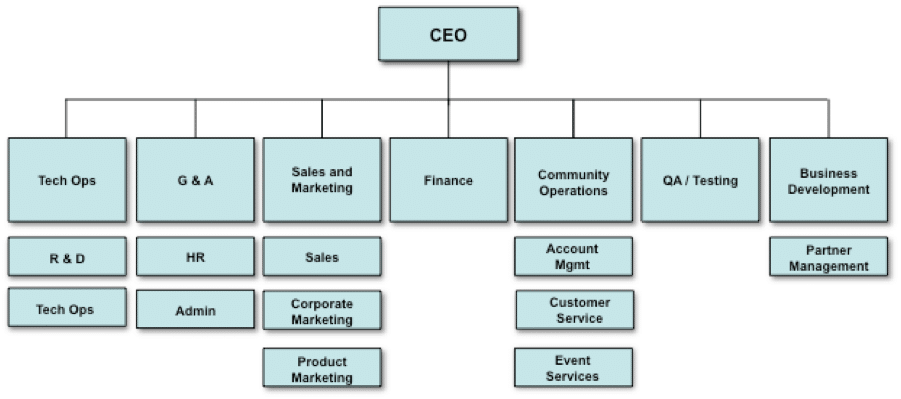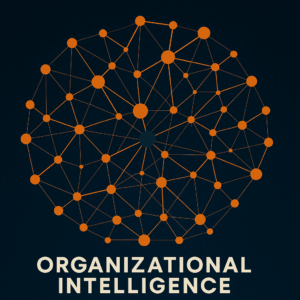Design Your Business Like It Matters
Summary Insight:
Your business isn’t underperforming because of people—it’s the structure. If you want different results, redesign the system to drive them.Key Takeaways:
- Structure drives behavior—strategy shifts require structural realignment or entropy wins.
- Avoid classic structural failures: effectiveness buried under efficiency, long-term crushed by short-term.
- Great orgs balance autonomy and control, match roles to natural styles, and evolve their structure ahead of the curve.
Form Follows Function: The 3 Elements of Organizational Structure & Design

- The functions it performs.
- The location of each function.
- The authority of each function within its domain.
What Happens When an Organization’s Structure Gets Misaligned?

The 5 Classic Mistakes in Organizational Structure

Mistake #1: The strategy changes but the structure does not
Every time the strategy changes — including when there’s a shift to a new stage of the execution lifecycle — you’ll need to re-evaluate and change to the structure. The classic mistake made in restructuring is that the new form of the organization follows the old one to a large degree. That is, a new strategy is created but the old hierarchy remains embedded in the so-called “new” structure. Instead, you need to make a clean break with the past and design the new structure with a fresh eye. Does that sound difficult? It generally does. The fact is that changing structure in a business can seem really daunting because of all the past precedents that exist – interpersonal relationships, expectations, roles, career trajectories, and functions. And in general, people will fight any change that results in a real or perceived loss of power. All of these things can make it difficult to make a clean break from the past and take a fresh look at what the business should be now. There’s an old adage that you can’t see the picture when you’re standing in it. It’s true. When it comes to restructuring, you need to make a clean break from the status quo and help your staff look at things with fresh eyes. For this reason, restructuring done wrong will exacerbate attachment to the status quo and natural resistance to change. Restructuring done right, on the other hand, will address and release resistance to structural change, helping those affected to see the full picture, as well as to understand and appreciate their new roles in it.Mistake #2: Functions focused on effectiveness report to functions focused on efficiency
Efficiency will always tend to overpower effectiveness. Because of this, you’ll never want to have functions focused on effectiveness (sales, marketing, people development, account management, and strategy) reporting to functions focused on efficiency (operations, quality control, administration, and customer service). For example, imagine a company predominantly focused on achieving Six Sigma efficiency (which is doing things “right”). Over time, the processes and systems become so efficient and tightly controlled, that there is very little flexibility or margin for error. By its nature, effectiveness (which is doing the right thing), which includes innovation and adapting to change, requires flexibility and margin for error. Keep in mind, therefore, that things can become so efficient that they lose their effectiveness. The takeaway here is: always avoid having functions focused on effectiveness reporting to functions focused on efficiency. If you do, your company will lose its effectiveness over time and it will fail.Mistake #3: Functions focused on long-range development report to functions focused on short-range results
Just as efficiency overpowers effectiveness, the demands of today always overpower the needs of tomorrow. That’s why the pressure you feel to do the daily work keeps you from spending as much time with your family as you want to. It’s why the pressure to hit this quarter’s numbers makes it so hard to maintain your exercise regime. And it’s why you never want to have functions that are focused on long-range development (branding, strategy, R&D, people development, etc.) reporting to functions focused on driving daily results (sales, running current marketing campaigns, administration, operations, etc.). For example, what happens if the marketing strategy function (a long-range orientation focused on branding, positioning, strategy, etc.) reports into the sales function (a short-range orientation focused on executing results now)? It’s easy to see that the marketing strategy function will quickly succumb to the pressure of sales and become a sales support function. Sales may get what it thinks it needs in the short run but the company will totally lose its ability to develop its products, brands, and strategy over the long range as a result.Mistake #4: Not balancing the need for autonomy vs. the need for control
The autonomy to sell and meet customer needs should always take precedence in the structure — for without sales and repeat sales the organization will quickly cease to exist. At the same time, the organization must exercise certain controls to protect itself from systemic harm (the kind of harm that can destroy the entire organization). Notice that there is an inherent and natural conflict between autonomy and control. One needs freedom to produce results, the other needs to regulate for greater efficiencies. The design principle here is that as much autonomy as possible should be given to those closest to the customer (functions like sales and account management) while the ability to control for systemic risk (functions like accounting, legal, and HR) should be as centralized as possible. Basically, rather than trying to make these functions play nice together, this design principle recognizes that inherent conflict, plans for it, and creates a structure that attempts to harness it for the overall good of the organization. For example, if Sales is forced to follow a bunch of bureaucratic accounting and legal procedures to win a new account, sales will suffer. However, if the sales team sells a bunch of underqualified leads that can’t pay, the whole company suffers. Therefore, Sales should be able to sell without restriction but also bear the burden of underperforming accounts. At the same time, Accounting and Legal should be centralized because if there’s a loss of cash or a legal liability, the whole business is at risk. So the structure must call this inherent conflict out and make it constructive for the entire business.Mistake #5: Having the wrong people in the right functions
I’m going to talk about how to avoid this mistake in greater detail in a coming article in this series but the basics are simple to grasp. Your structure is only as good as the people operating within it and how well they’re matched to their jobs. Every function has a group of activities it must perform. At their core, these activities can be understood as expressing PSIU requirements. Every person has a natural style. It’s self-evident that when there’s close alignment between job requirements and an individual’s style and experience, and assuming they’re a #1 Team Leader in the Vision and Values matrix, then they’ll perform at a high level. In the race for market share, however, companies make the mistake of mis-fitting styles to functions because of perceived time and resource constraints. For example, imagine a company that just lost its VP of Sales who is a PsIu (Producer/Innovator) style. They also have an existing top-notch account manager who has a pSiU (Stabilizer/Unifier) style. Because management believes they can’t afford to take the time and risk of hiring a new VP of Sales, they move the Account Manager into the VP of Sales role and give him a commission-based sales plan in the hope that this will incentivize him to perform as a sales person. Will the Account Manager be successful? No. It’s not in his nature to hunt new sales. It’s his nature to harvest accounts, follow a process, and help customers feel happy with their experience. As a result, sales will suffer and the Account Manager, once happy in his job, is now suffering too. While we all have to play the hand we’re dealt with, placing people in misaligned roles is always a recipe for failure. If you have to play this card, make it clear to everyone that it’s only for the short run and the top priority is to find a candidate who is the right fit as soon as possible.How to Design Your Organization’s Structure

Structure Done Wrong: An Example to Avoid
Below is a picture of a typical business structure done wrong. The company is a software as a service (Saas) provider that has developed a new virtual trade show platform. They have about ten staff and $2M in annual revenues. I received this proposed structure just as the company was raising capital and hiring staff to scale its business and attack multiple industry verticals at once. In addition to securing growth capital, the company’s greatest challenge is shifting from a startup where the two co-founders do most everything to a scalable company where the co-founders can focus on what they do best.
Structure Done Right
Below is a picture of how I realigned the company’s structure to match its desired strategy. Here are some of the key things to recognize about this new structure and why it’s superior to the old one. Each box represents a key function that must be performed by the business in its chosen strategy. Again, this is not an org chart. One function may have multiple people such as three customer service reps within it and certain staff may be wearing multiple different hats. So when creating the structure, ignore the people involved and just identify the core business functions that must be performed. Again, first we want to create the right structure to support the chosen strategy. Then we can add roles and hats.
How to Read this Structure
At the bottom of the structure you’ll see an arrow with “decentralized autonomy” on the left and “centralized control” on the right. That is, your goal is to push decision-making and autonomy out as far as possible to the left of the structure for those functions closest to the customer. At the same time you need to control for systemic risk on the right of the structure for those functions closest to the enterprise. There is a natural conflict that exists between decentralized autonomy and centralized control. This structure recognizes that conflict, plans for it, and creates a design that will harness and make it constructive. Here’s how. Within each function, you’ll see a label that describes what it does, such as CEO, Sales, or Engineering. These descriptions are not work titles for people but basic definitions of what each function does. Next to each description is its primary set of PSIU forces. PSIU is like a management shorthand that describes the forces of each function. For example, the CEO function needs to produce results, innovate for changing demands, and keep the team unified: PsIU. Identifying the PSIU code for each function is helpful for two reasons. One, it allows a shared understanding of what’s really required to perform a function. Two, when it’s time to place people into hats and roles within those functions, it enables you to find a match between an individual’s management style and the requirements for the role that needs to be performed. For example, the Account Management function needs to follow a process and display a great aptitude towards interaction with people (pSiU). Intuitively you already know that you’d want to fill that role with a person who naturally expresses a pSiU style. As I mentioned earlier, it would be a mistake to take a pSiU Account Manager and place them into a Sales role that requires PSiu, give them a commission plan, and expect them to be successful. It’s against their very nature to be high-driving and high-charging and no commission plan is going to change that. It’s always superior to match an individual’s style to a role rather than the other way around. Now that you understand the basics of this structure, let’s dive into the major functions so you can see why I designed it the way I did.The General Manager (GM) Function
The first and most important thing to recognize is that, with this new structure, it’s now clear how to scale the business. The green boxes “GM Vertical #1 and #2” on the far left of the structure are called business units. The business units represent where revenues will flow to the organization. They’re colored green because that’s where the money flows. The GM role is created either as a dedicated role or in the interim as a (hat) worn by the CEO until a dedicated role can be hired. Each business unit recognizes revenue from the clients within their respective vertical. How the verticals are segmented will be determined by business and market needs and the strategy. For example, one GM may have authority for North America and the other Asia/Pacific. Or one might have authority for the entertainment industry and the other the finance industry. Whatever verticals are chosen, the structure identifies authority and responsibility for them. Notice that the code for the GM/PsIU is identical to the CEO/PsIU. This is because the GMs are effectively CEOs of their own business units or can be thought of as future CEOs in training for the entire organization. Underneath each green business unit is a Sales role, responsible for selling new accounts and an Account Management role, responsible for satisfying the needs of key clients. Essentially, by pushing the revenue driving functions to the far left of the structure, we are able to decentralize autonomy by giving each GM the authority and responsibility to drive revenue, acquire new customers, meet the needs of those customers. Each GM will have targets for revenue, number of customers, and client satisfaction. They also have a budget and bonus structure.The Product Manager (PM) Function
To the immediate right of the green business units is a black box called “PM” or Product Manager. The function of the Product Manager is to manage the competing demands of the different verticals (the green boxes to its left) as well as the competing demands of the other business functions (the grey boxes to its right) while ensuring high product quality and market fit and driving a profit. The grey boxes to the right of the Product Manager — CEO, Finance, Operations, Engineering, Marketing Strategy, and Admin — represent the rest of the core organizational functions. Effectively, these functions provide services to the green business units so that those units have products to sell to their markets. The revenue that the business generates pays for those internal services. Profits are derived by subtracting the cost of those services from the revenues generated by the business units. A Launch Manager who helps to coordinate new product releases between the business units supports the Product Manager. The code for the Product Manager is pSiU. That is, we need the Product Manager to be able to stabilize and unify all of the competing demands from the organization. What kind of competing demands? The list is almost endless. First, there will be competing demands from the verticals. One vertical will want widget X because it meets the needs of their customers; the other will want widget Z for the same reasons (and remember that this particular company’s strategy is to run multiple verticals off a single horizontal platform). Operations will want a stable product that doesn’t crash and integrates well within the existing infrastructure. Engineering will want a cutting-edge product that displays the latest functions. Marketing Strategy will want a product that matches the company’s long-range plans. Administration will want a product that doesn’t cause the company to get sued. The CEO will want a product that tells a great story to the marketplace. Finance will want a product that generates significant ROI or one that doesn’t require a lot of investment, depending on its lifecycle stage. So the list of inherent conflicts runs deep. The reason we don’t want a psIu in the Product Manager is that at this stage of the company’s lifecycle, the innovative force is very strong within the founding team, which will continue to provide that vision and innovation in another role, new Vertical Development and R&D under Marketing Strategy (more on this later). Nor do we want a Psiu in the Product Manager function because a big producer will focus on driving forward quickly and relentlessly (essential in the earlier stages of the product lifecycle) but will miss many of the details and planning involved with a professional product release (essential at this stage of the product lifecycle). It’s worth discussing why we want the product P&L to accrue to the Product Manager function and not the CEO or GMs. By using this structure, the CEO delegates autonomy to the GMs to drive revenue for their respective verticals and for the Product Manager to drive profits across all verticals. Why not give P&L responsibility to the CEO? Of course the ultimate P&L will roll up to the CEO but it’s first recognized and allocated to the Product Manager. This allows the CEO to delegate responsibility for product execution in the short run while also balancing the long-range needs of the product and strategy. We don’t give the Product Manager function to the GMs at this stage for a different reason. If we did, the product would have an extreme short-run focus and wouldn’t account for long-run needs. The business couldn’t adapt for change and it would miss new market opportunities. However, the GMs will need to have significant input into the product features and functions. That’s why the Product Manager is placed next to the GMs and given quite a lot of autonomy – if the product isn’t producing results in the short run for the GMs, it’s not going to be around in the long run. At the same time, the product must also balance and prioritize long-range needs and strategy and that’s why it doesn’t report to the GMs directly. If the business continues to grow, then one of the GMs will become the head of an entire division. Think of a division as a grouping of multiple similar verticals. In this case, the Product Manager function may in fact be placed under the newly formed division head because it is now its own unique business with enough stability and growth to warrant that level of autonomy. Remember that structures aren’t stagnant and they must change at each new stage of the lifecycle or each change in strategy. For this current stage of the lifecycle, creating a dynamic tension between the GMs, the Product Manager, and the rest of the organization is highly desired because it will help to ensure a sound product/market/execution fit. I’ll explain more of how this tension plays out and how to harness it for good decision making in the next article.The Operations Function
To the immediate right of the Product Manager is Operations. This is the common services architecture that all GMs use to run their business. It is designed for scalable efficiency and includes such functions as Customer Service and Technology Infrastructure. Notice how all of these functions are geared towards short-run efficiency, while the business still wants to encourage short-term effectiveness (getting new clients quickly, adapting to changing requests from the GMs, etc.) within these roles and so it gives more autonomy to this unit than to those to the right of it. The code for Operations is PSiU because we need it to produce results for clients every day (P); it must be highly stable and secure (S); and it must maintain a client-centric perspective (U). It’s important to recognize that every function in the business has a client that it serves. In the case of Operations, the clients are both internal (the other business functions) as well as external (the customers).The Engineering Function
Going from left to right, the next core function is Engineering. Here the core functions of the business include producing effective and efficient architectures and designs that Operations will use to run their operations. This includes SW Design, SW Development, and QA. Notice, however, that the ultimate deployment of new software is controlled by the Product Manager (Launch Manager) and that provides an additional QA check on software from a business (not just a technology) perspective. Similar to Operations, Engineering is also short-run oriented and needs to be both effective and efficient. It is given less relative autonomy in what it produces and how it produces it due to the fact that Engineering must meet the needs of all other business functions, short- and long-run. The code for Engineering is PSIu because we need it to produce results now (P) and to have quality code, architecture, and designs (S), and to be able to help create new innovations (I) in the product.The Marketing Strategy Function
The next core function is Marketing Strategy. Marketing Strategy is the process of aligning core capabilities with growing opportunities. It creates long-run effectiveness. It’s code is psIu because it’s all about long-term innovation and nurturing and defending the vision. Sub-functions include new Vertical Development (early stage business development for future new verticals that will ultimately be spun out into a GM group), R&D (research and development), Marketing Execution (driving marketing tactics to support the strategy), PR, and People Development. A few of these sub-functions warrant a deeper explanation. The reason new Vertical or Business Development is placed here is that the act of seeding a new potential vertical requires a tremendous amount of drive, patience, creativity, and innovation. If this function were placed under a GM, then it would be under too much pressure to hit short-run financial targets and the company would sacrifice what could be great long-term potential. Once the development has started and the vertical has early revenue and looks promising, it can be given to a new or existing GM to scale. The purpose of placing R&D under Marketing Strategy is to allow for the long-run planning and innovative feature development that can be applied across all business units. The short-run product management function is performed by the Product Manager. The Product Manager’s job is to manage the product for the short run while the visionary entrepreneur can still perform R&D for the long run. By keeping the Product Manager function outside of the GM role, New Product Development can more easily influence the product roadmap. Similarly, by keeping the Product Manager function outside of Marketing Strategy, the company doesn’t lose sight of what’s really required in the product today as needed by the GMs. Similarly, if the R&D function was placed under Engineering, it would succumb to the short range time pressure of Engineering and simply become a new feature development program — not true innovative R&D. The reason Marketing Execution is not placed under the GM is that it would quickly become a sales support function. Clearly, the GM will want to own their own marketing execution and he or she may even fight to get it. It’s the CEO’s role, however, to ensure that Marketing Execution supports the long-range strategy and thus, Marketing Execution should remain under Marketing Strategy. The basis for placing People Development under Marketing Strategy rather than under HR is that People Development is a long-range effectiveness function. If it’s placed under HR, then it will quickly devolve into a short-range tactical training function. For a similar reason, recruitment is kept here because a good recruiter will thrive under the long-range personal development function and will better reflect the organization’s real culture.The Finance & Admin Functions
To the far right of the organization are the Administrative functions. Here reside all of the short-run efficiency or Stabilizing functions that, if performed incorrectly, will quickly cause the organization to fail. These functions include collecting cash Controller (AR/AP), Legal, and the HR function of hiring and firing. Notice, however, that the Finance function is not grouped with Admin. There are two types of Finance. One, cash collections and payments, is an Admin function. The other, how to deploy the cash and perform strategic financial operations, is a long-run effectiveness function. If Finance is placed over Admin, or under Admin, the company will either suffer from lack of effectiveness or a lack of efficiency, respectively. It also creates a tremendous liability risk to allow one function to control cash collections and cash deployments. It’s better to separate these functions for better performance and better control.The CEO Function
The top function is the CEO. Here resides the ultimate authority and the responsibility to keep the organization efficient and effective in the short and long run. The code for the CEO is PsIU because this role requires driving results, innovating for market changes, and keeping the team unified. By using this structure, the CEO delegates autonomy to the GMs to produce results for their respective verticals. The GMs are empowered to produce results and also to face the consequences of not achieving them by “owning” the revenue streams. The CEO has delegated short-run Product Management to produce a profit according to the plan and simultaneously balances short- and long-run product development needs. At the same time, the CEO protects the organization from systemic harm by centralizing and controlling those things that pose a significant liability. So while the GMs can sell, they can’t authorize contracts, hire or fire, or collect cash or make payments without the authorization of the far right of the structure. Nor can they set the strategy, destroy the brand, or cause a disruption in operations without the authority of the CEO and other business units. The goal of structure is to create clarity of authority and responsibility for the core organizational functions that must be performed and to create a design that harness the natural conflict that exists between efficiency and effectiveness, short-run and long-run, decentralization and control. A good CEO will encourage the natural conflict to arise within the structure and then deal with it in a constructive way. More on how to do this in the next section. Remember that within any structure, individuals will play a role and, especially in a start-up environment, wear multiple hats. How you fill roles and hats is to first identify and align the core functions to support the organization’s strategy. Then, assign individuals to those functions as either a role or a hat. In this particular structure, the role of CEO was played by one founder who also wore the temporary hats of GM Vertical #1 and #2 until a new GM could be hired. The other founder played the role of Product Manager, as well as Engineer until that role could be hired. Clearly delineating these functions allowed them both to recognize which roles they needed to hire for first so that they could give up the extra hats and focus on their dedicated roles to grow the business. Going forward, both founders will share a hat in Marketing Strategy with one focused on new Business Development and the other on R&D. These Marketing Strategy hats play to the strength of each founder and allow them to maintain the more creative, agile aspects of entrepreneurship while the business structure is in place to execute on the day-to-day strategy.Summary of Organizational Structure & Design
To recap, design controls behavior. When an organization’s structure is misaligned, its resistance to change will be great and its execution will be slow. Organizational structures get misaligned over time for many reasons. The most basic of these is inertia, through which companies get stuck in old ways of doing things. When restructuring your organization, there are some classic mistakes to avoid. First, always redesign the structure whenever you change the strategy or shift to a new lifecycle stage (do this even if there are no personnel changes). Second, avoid placing efficiency-based functions such as operations or quality control over effectiveness-based functions such as R&D, strategy, and training. Third, avoid giving short-range functions like Sales, Operations, and Engineering power over long-range functions like Marketing, R&D, and People Development. Fourth, distinguish between the need to decentralize autonomy and centralize control and structure the organization accordingly. Finally, avoid placing the wrong style of manager within the new structural role simply because that’s the past precedent. Changing structures can be really hard because there’s so much past precedent. If the organization is going to thrive, however, the new structure must support the new strategy. In the next article, I’m going to discuss the most important process of any business: the decision making and implementation that brings the structure alive.Need help designing and integrating a new organizational structure? Contact Lex for an initial consultation.Next to The Most Important Process in Your Business: Or, How to Make Good Decisions and Implement Them Fast




